Dura-Ace is the admiral ship of Shimano, the Japanese (now multinational) manufacturer of cycling components (and some other things like fishing tackle and rowing equipment). Here is a brief history of the Shimano Dura-Ace.
1973: The first Dura-Ace release
The story begins in 1973, the same year that the Campagnolo Super Record group was introduced. The first Dura-Ace was built using aluminum. It was Shimano’s first attempt at the professional quality road racing component group niche which was dominated by Campagnolo, the Italian manufacturer who was unchallenged for years.
There were two types of rear derailleur (short-cage, up to 28-teeth compatible, and the long-cage, up to 34-teeth compatible). The cranks were 39/52 165mm, 45/54 165mm, 39/52 170mm, and 45/54 170mm.
The “pro” model had 5/6 speed options, while the “touring” model was 5-speed.
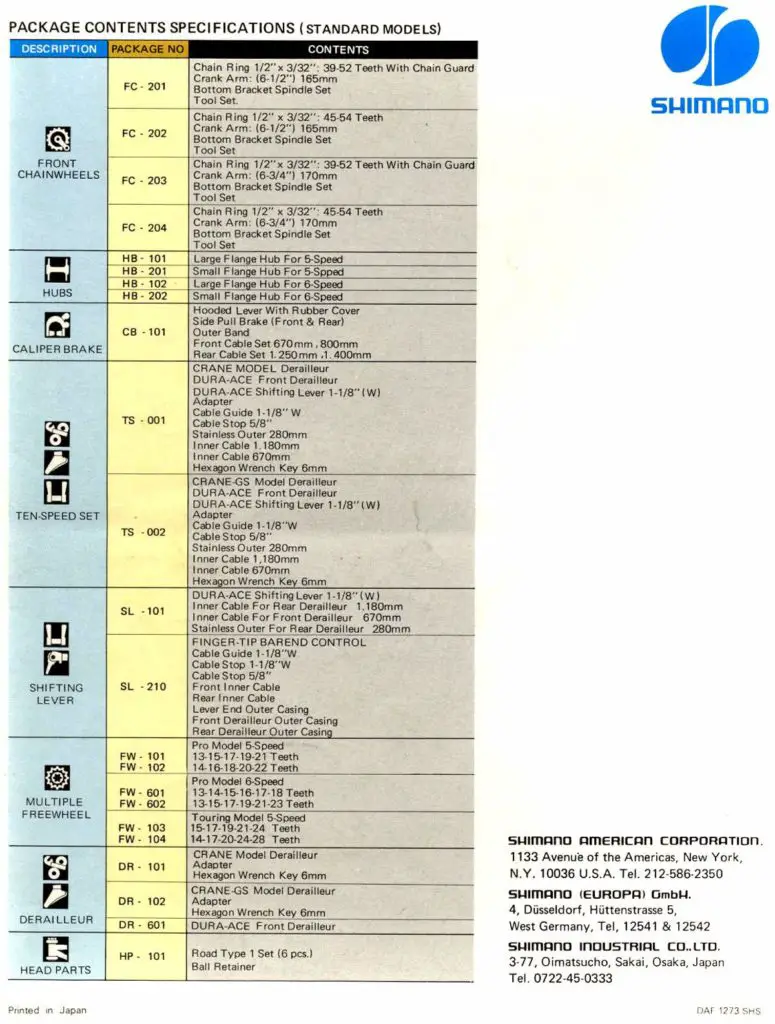

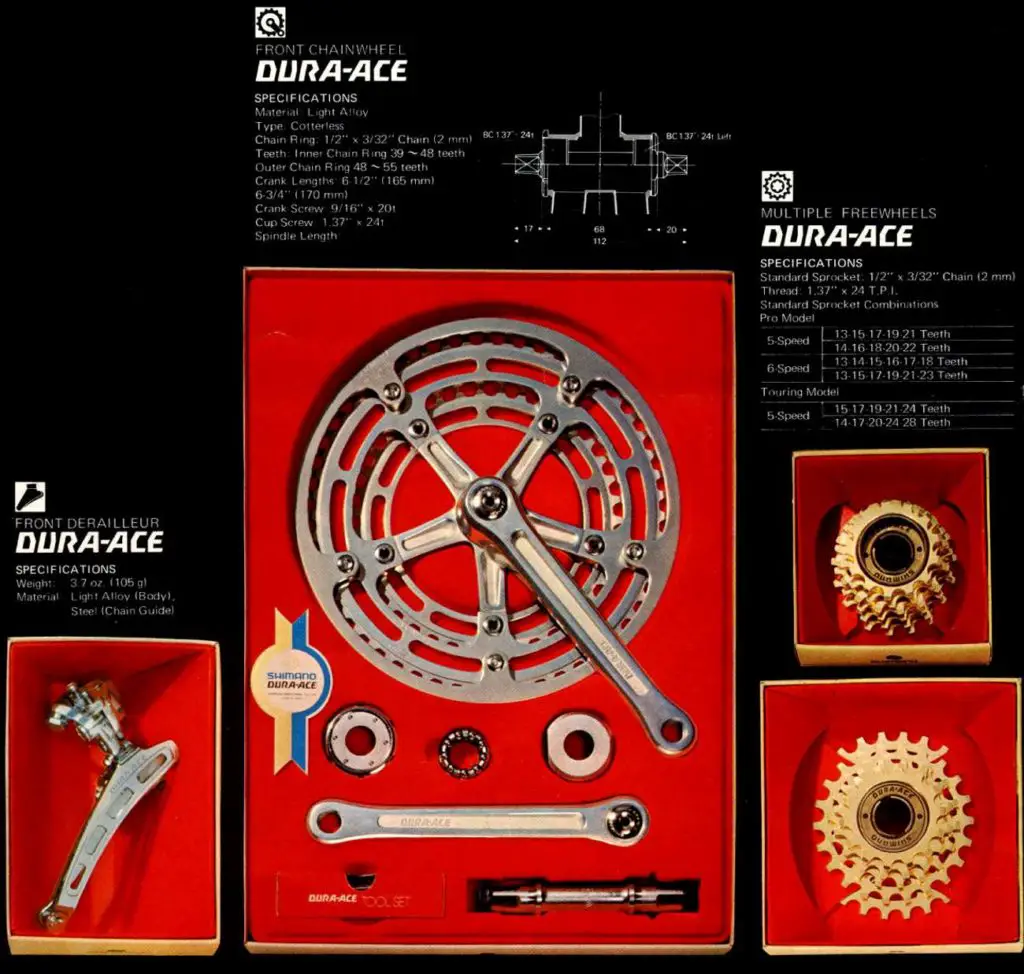

1976: Dura-Ace 10
It was a track groupset that used a 10mm pitch chain and gears.
Almost all bike chains are half-inch pitch, so the centers of the pins are half an inch, or 12.7mm, apart. Introduced in 1976, and discontinued sometime in the 80s, Dura-Ace 10 used a smaller chain and therefore smaller chainrings and sprockets – the number of teeth was the same, but they were closer together.
The biggest advantage was lower weight, and eventually, according to legend, the Japanese Keirin federation banned the 10mm pitch equipment because it might give some riders an unfair advantage.

1977: Dura-Ace 7100
It was the second generation Dura-Ace. It was slightly different from the First Generation parts. Crank arms appear to be the same, but with different rings and used standard pedal threading.

1978: Dura-Ace EX 7200
The Dura-Ace EX 7200 introduced Shimano’s EX concept as being a design optimized for the (then radical) idea of using 6-speed, particularly with the new freehubs.

1980: Dura-Ace AX 7300
Shimano Dura-Ace AX 7300 comes out in 1980. It is specifically designed to be more aerodynamic.
Despite being a commercial disaster (Dura-Ace series were not really successful until the introduction of the indexed shifting, the “Shimano Index System – SIS” in 1984), the AX 7300 is arguably one of the foundation stones of Shimano’s current success.
It created a fear of being left behind that forced every other derailleur manufacturer in the world to redesign their own derailleurs to incorporate “aerodynamic” elements. With the European manufacturers already on their knees, and SunTour about to be clobbered by technical problems, this expenditure crippled every one of Shimano’s competitors.
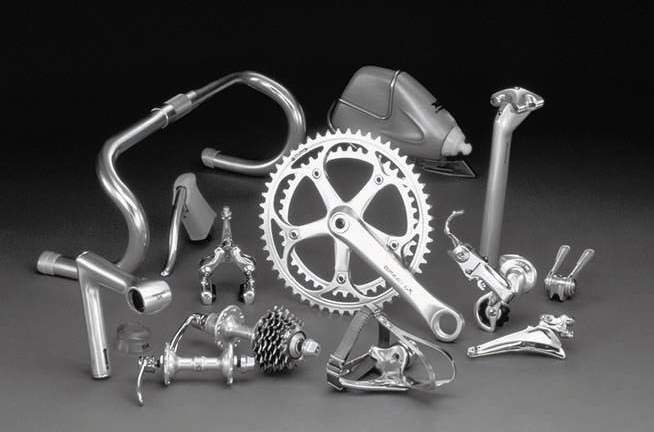
1984: Dura-Ace 7400 series with Shimano Indexed Shifting (SIS)
In 1984, Shimano introduced the revolutionary Dura-Ace S.I.S. (Shimano Indexed Shifting), the first successful indexed-shifting system in cycling history. It was a 6-speed system (then 7 and 8-speed with the new versions) with indexed shifters mounted on the down tube.
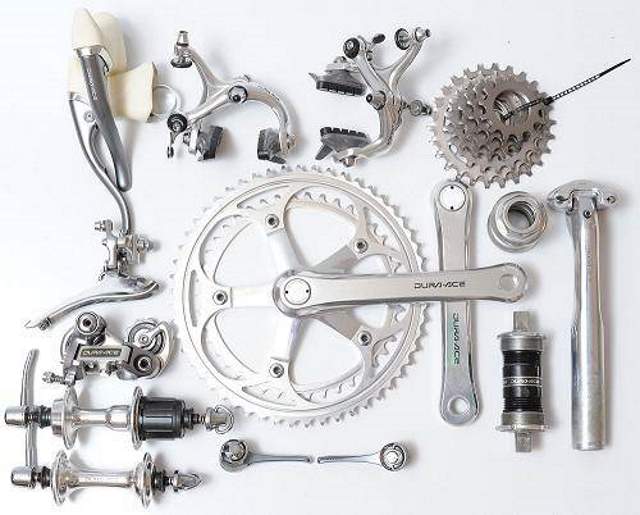
1988: The First Grand Tour Victory: Giro d’Italia
In 1988, Andy Hampsten (Seven-Eleven Team) won the Giro d’Italia with the Dura-Ace groupset.
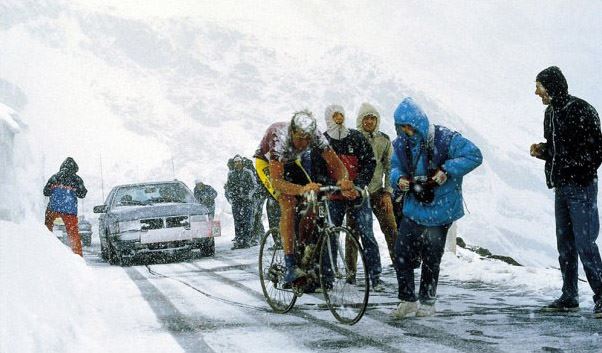
1990: Dura-Ace 7400 series with Dual Control Levers
The dual-control lever incorporates a shifter mechanism into the brake lever, making it possible to change speeds without removing one’s hands from handlebars. Another revolutionary upgrade.
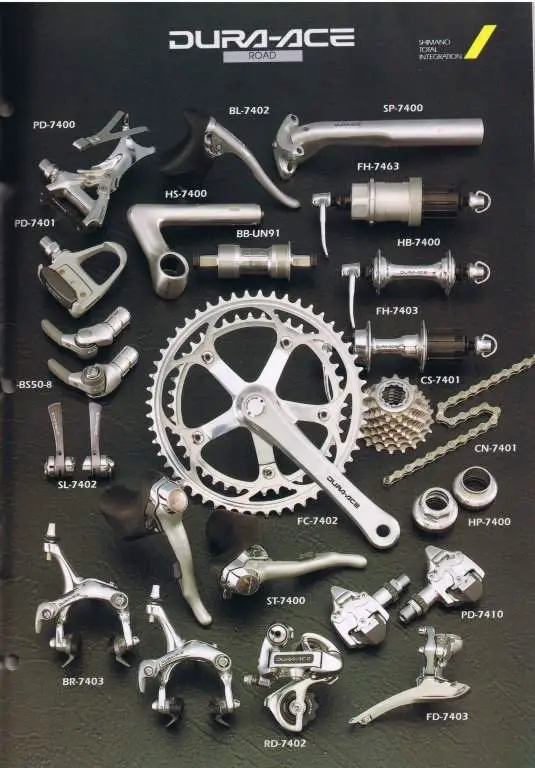
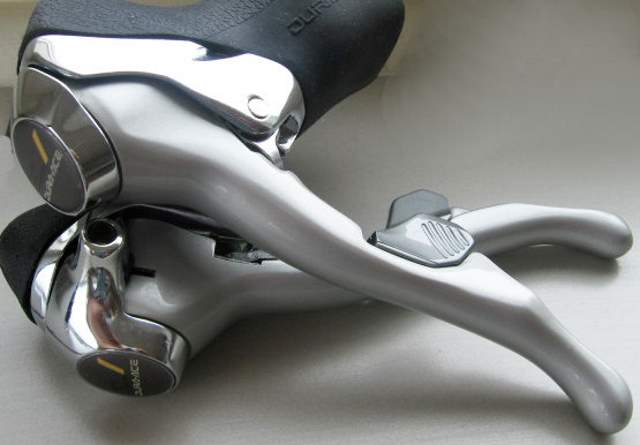
1993: Dura-Ace 7410
It was actually the last of the Dura-Ace 7400 series but was enough of a departure from the original 7400 series that many sources list it as a separate group.
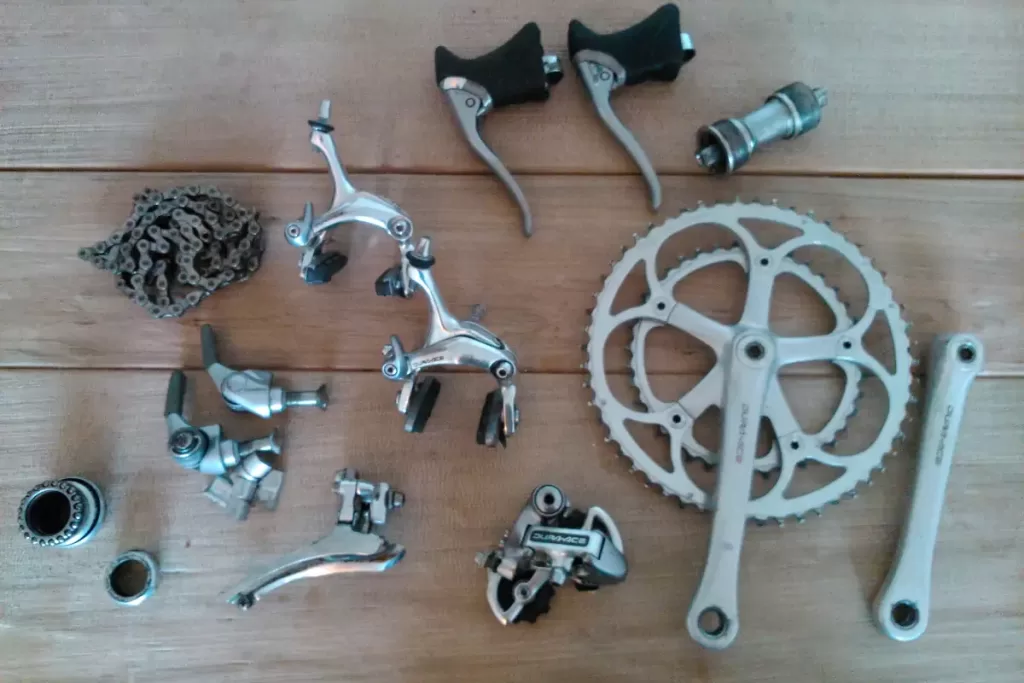
1996: Dura-Ace 7700
7700 series are developed after a thorough review of the previous derailleur system based on the philosophy of “Stress-Free”.
A review about DA 7700 that I like: “Reining from 1996 to 2004 as Shimano’s top-end groupset, it is arguable that DA 7700 lacks the technological punch to stand out on its own against breakthrough DA 7400 or ultra-refined DA 7800. It was just a sort of 9-speed filler between the two. But in 1999 it was this component group that allowed Shimano to finally climb to the top of the podium at the Tour de France. A cyclist from Texas, USA may have helped it get there.” (campagnolodelta.blogspot.com)
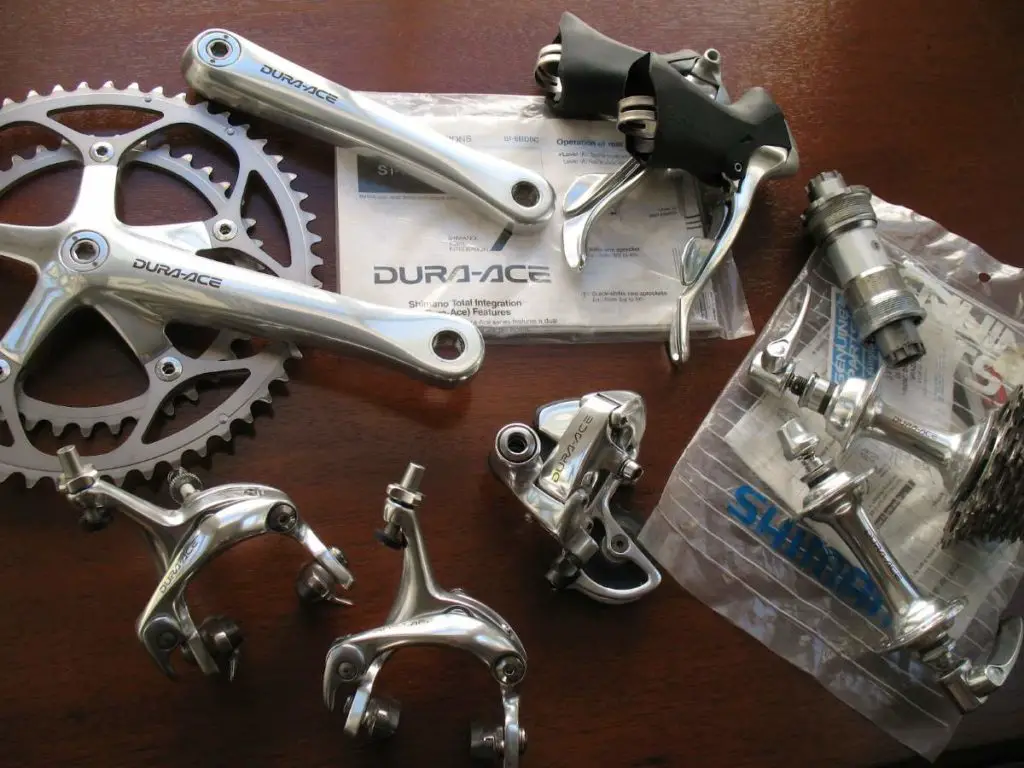
1998: Dura-Ace 25th Anniversary Groupset
This series is a special Dura-Ace released in commemoration of 25 years since its introduction into the market.

1999: The first (now annulled) Tour de France victory
Lance Armstrong of the US Postal Team won the Tour de France 1999 using Dura-Ace 7700 groupset, but the U.S. Anti-Doping Agency (USADA) stripped his all seven Tour de France titles in 2012.
2004: Dura-Ace 7800
Dura-Ace 7800 series components are developed with “For 100% Power Transmission Efficiency” as a catchword. This series consisted of 10-speed rear drive trains, HOLLOWTECH Ⅱ cranksets, ergonomic dual control levers, and other higher performance components. It was the first 10-speed group on the market.

2007: The first (not annulled) Tour de France victory
Alberto Contador, the Spanish rider of the Discovery Channel team won the 2007 Tour de France using Dura-Ace 7800 groupset. As of 2024, Shimano has a total of 12 Tour de France victories.
2008: Dura-Ace 7900
The 7900 series components were developed under the concept of “Evolution of Perfection”. A derailleur comprising these components embedded the shift cable completely. Its crankset consisted of a HOLLOWGRIDE (hollow gear) in addition to a HOLLOWTECH Ⅱ. All other components were also reviewed for optimal design. The weight of the groupset w/out hubs was reduced from 2181 grams (DA 7800) to 2052 grams (DA 7900).

2009: Dura-Ace Di2 (electronic)
2009 Electronic Shifting System DURA-ACE 7970 is in the market. A new technology called “Digital Integrated Intelligence (or Di2 for short) was introduced into Dura-Ace. The Dura-Ace 7900 series equipped with this electronic shifting system provides racers with a “complete stress-free” function. Enhanced shifting performance is the most obvious benefit of Shimano’s Di2.
“A solution to a problem that doesn’t exist.” “Unnecessary.” “A marketing gimmick.” Those were lines offered against Shimano’s Dura-Ace Di2 electronic drivetrain, but it quickly became a racing standard. Today, almost every pro team uses electronic shifters.

2012: Dura-Ace 9000 (11-speed)
The new series has been fully re-engineered across every system. Highlights include a very robust four-arm crankset, the new SLR-EV brake system, and a new 11-speed drive train. 9000 is mechanical and 9070 is electronic (Di2) series.

2016 – Dura-Ace R9100/R9150
Dura-Ace R9100 (mechanical) and R9150 (electronic) series came with an integrated power meter (which has been ten years in development), the first-ever Dura-Ace hydraulic disc brakes, and the option of synchronized front and rear derailleur shifting to minimize cross-gearing. The crankset and the front and rear derailleurs were also redesigned.
Another change point is the largest sprocket size: it was 28-tooth on previous versions of Dura-Ace, but now the new version is offering an 11-30-tooth cassette.
Shimano use codes R9100 and R9150 for the groups with classic rim brakes, and R9120 and R9170 for the groups with hydraulic disk brakes.

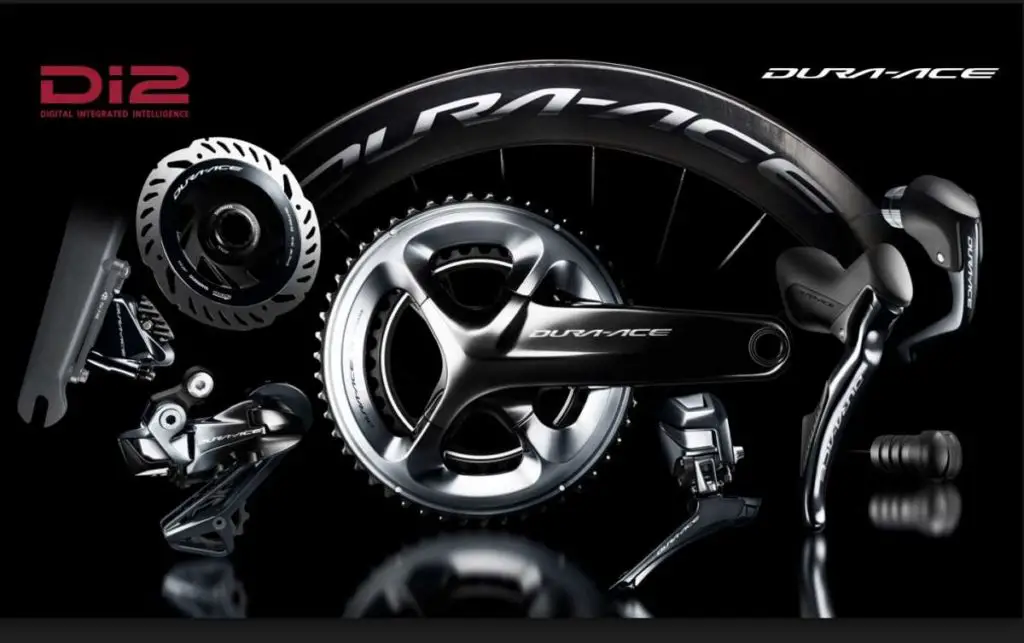
2021: Dura-Ace R9200/R9250/R9270, 12-speed and semi-wireless
Dura-Ace R9200 is Shimano’s new generation top-level groupset and has some big changes from its predecessor, including super-smooth Hyperglide +, a 12-Speed cassette, and wireless shifters.
Some key points are:
- For the first time ever, there’s no mechanical shifting option: the mechanical Dura-Ace is now history.
- R9270: Disc brakes with electronic shifting
- R9250: Rim brakes with electronic shifting
- Interestingly, the new version is slightly heavier than its predecessor, the R9100.
- It is available in both rim brake and disc brake variants – but the disk brake version has wireless levers.
- 300-hour battery life (same as the previous R9100)
- The derailleurs and main battery are wired-in
- The new series has the fastest (and most precise) shifting in all Dura-Ace versions.
- 11-34 cassette option
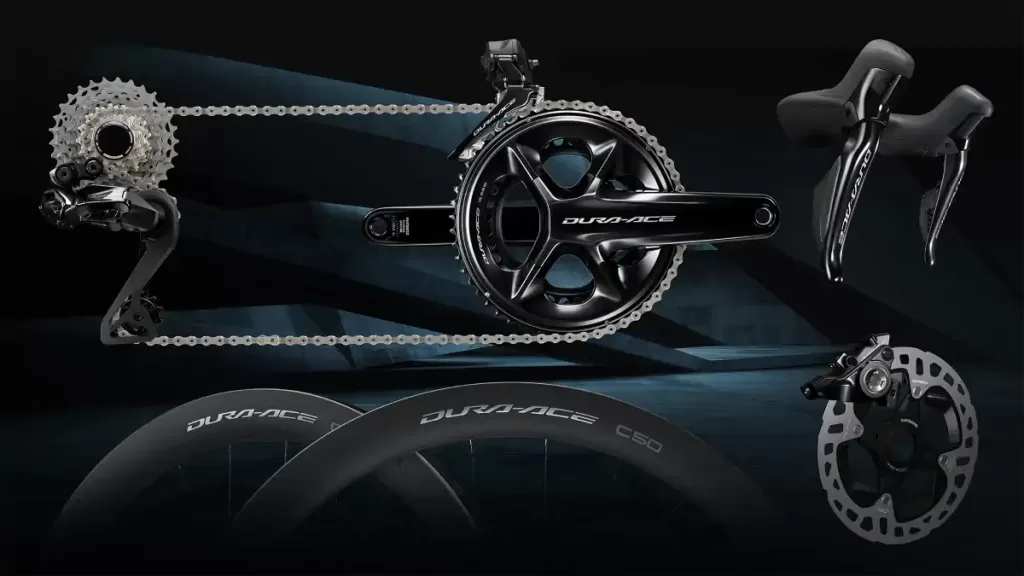
Sources
- Shimano on Wikipedia
- Shimano Dura-Ace Compatibility and History on SheldonBrown.com
- Dura-Ace 10 Pitch on Fixed Gear blog
- Shimano on Merlin Cycles
- Shimano Dura-Ace AX (7300) on disraeligears.co.uk
- campagnolodelta.blogspot.com
- “New 12-speed Shimano Dura-Ace R9200 is finally here and it’s RIP for mechanical groupsets” on the Bike Radar website
- UCI Elite Men Road Race World Champions: The Complete List [1927-2025] - September 28, 2025
- What Is Zone 2 In Cycling? - September 12, 2025
- The Turkish Flag at the Tour de France: Who’s Waving It at the Finish Line? - July 30, 2025

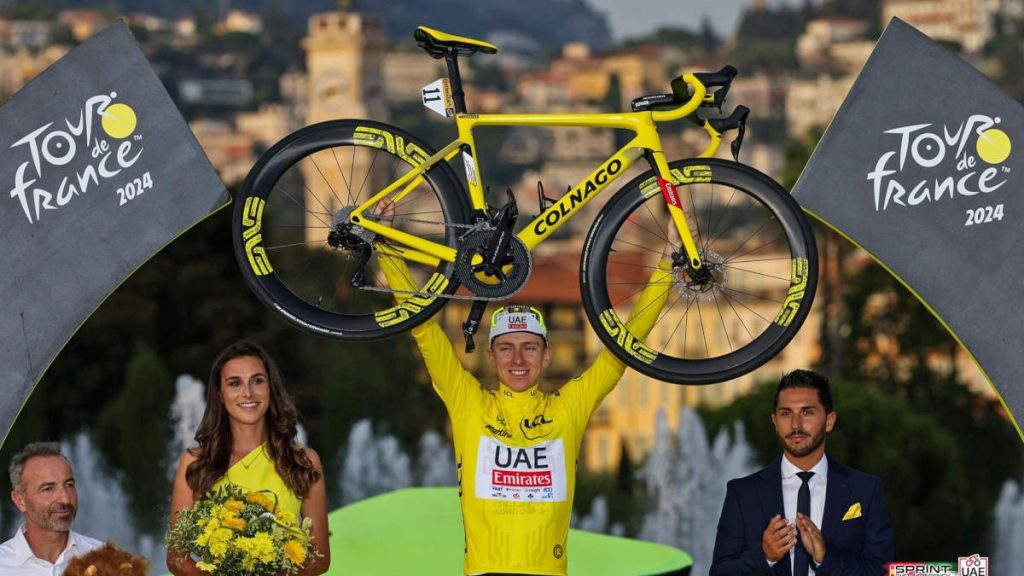
13 replies on “Dura-Ace History”
Hi Özgür
Congratulations. Nice historic view on Shimano Parts.
I am a former amateur cyclist from 85 to 93. My favorite
bike, was the koga myjata full pro from 1990 with Dura ace
7400 and the First and famous STI grip shifter.
Now, 30 years later, I would like to refurbish the bike.
Due to some Racing crashes, the STI shifter are looking really
Battered. Do you know, if there is a shop, That has new
Components from this 7400 group?
Best regards
Matthias
Very nice timeline of the iconic Dura Ace groups.
It is not Hampsten but Johan van der Velde on the Gavia in 1988. Can remember the TV broadcasting very well.
Ciao,
Antoine Vos
Muchísimas gracias por la información he buscado páginas y no me daban tan exacta la información excelente deberían hacer porfa si tienen mascones sram y campagnolo Muchas gracias.
Thank you for sharing detailed guide about Dura-Ace Groupset. What are you reviews about Shimano Sora?
Thanks for a great article. Shimano had Campagnolo on the ropes and fighting to keep up from the release of 7200 EX onwards. It took Campag over a decade to develop a cassette hub, and the 7200 Dyna-Drive chainsets looked like something from science fiction compared to old-fashioned Record cranks of the time. Campagnolo was way behind in terms of technology and performance. The differences are cultural. The Japanese consider systems that work together rather than individual products – see Nikon or Canon for other examples of this philosophy. They innovate and take technical risks. They invest in the future. They are good at business, manufacturing, and global supply. They quickly address trends in the market. In Italy, it seems to be much more about history, tradition, and style, with the lethargic arrogance of due entitlement. Campagnolo’s C-Record groupset of the late eighties was absolute proof of this. C-Record looked lovely, but was really heavy, aped the look of Dura-Ace AX 7300 from some five years earlier, and introduced no new technology – no indexing, no cassette hubs, no shift enhancement features. The Delta brakes were so bad that two immediate revisions were necessary and many top pros wouldn’t use them, and Campagnolo had to re-introduce the previous Record calipers but with a gimmicky plastic gem added on the locknut. When it came to brifters, Campagnolo had to resort to a collaboration with the engineers of German brand Sachs to bring Ergopower to market – a full two seasons after Shimano’s STI. Another failure was Campagnolo’s SGR clipless pedal system before they reverted to licensing Look’s proven system. Campagnolo’s MTB effort was a dismal failure, with very heavy, ugly, and unreliable components. More recently, with the uptake of disc braking for road bikes, Campagnolo had to partner with Formula. Shimano’s design and engineering has always been in-house, and they’ve never had to rely on collaborations with anyone. When Campagnolo finally introduced their complex Ultra-Torque oversize BB axle system, Shimano was already into their second generation of successful oversize axle designs. Then there’s the EPS debacle, finally released well over a decade (perhaps two decades!) after the first prototypes had been tested by pro teams. Campagnolo was always a joke compared to Shimano from the early eighties onwards, but the power of that history, tradition, and style has amazing marketing value. We cyclists can be suckers. We often buy bikes with their hearts rather than our heads, and hence Campagnolo still has a place in the market.
Thanks for the very informative comment, David! Are you the cycling historian David Palk?
I’d argue that the biggest shifting innovation was the slanted parallelogram rear derailleur. Who invented this David?
Shimano cranks have a marked tendency to split in two lengthways. Given the number I have personally seen, not just read about or seen pictures of, I think anyone continuing to use their hollow tech II cranks has to have a death wish or a very blinkered approach to their own safety.
Shimano whilst having a cassette hub earlier have had a tendency to change the design rather frequently. They repeatedly burned anyone unfortunate enough to invest in their hubs or wheels.
Think of the move from uniglide to hyperglide. The move to 7800 hubs which only allowed use of the specific Shimano 10 speed cassette, then the wider body needed for 11 speed which at a stroke made all the older Shimano own-brand wheels redundant. You could argue that people who bought into Shimano were the biggest suckers of all. Of course in MTB there is a new 12 speed specific body.
Campagnolo may have been later with a cassette hub but I can still run any older 9 speed hubs with current 12 speed cassettes.
We could not buy Shimano road disc pads for many months. They were simply unavailable. There appears to have been a priority to supply OEMs at the expense of servicing the aftermarket.
Lastly the article incorrectly states that 7800 was the first 10 speed group around 2004. Campagnolo introduced 10 speed for the 2000 model year.
Lol, I can use the 8 speed cassette from 1998 on the newest 12-speed Shimano body. On the other hand, I need to replace wheel in my second bike equipped with Campagnolo Record the 8-speed group. What can I do? I have two choices, either to buy an old NOS wheel, or to use a Shimano cassette with almost any wheel, because it is more or less compatible with Campa derailleur.
This is cool! Thanks for putting this together; having a chronological history of the groups helped me locate a small part I needed. Like you, I write software and I’m a former amateur road racer (1979-1986 in Southern California). My team (North Hollywood Wheelmen) was sponsored by Shimano. I raced on the Dura-Ace EX and AX groups, before leaving for another team that was sponsored by SunTour (Velo Club La Grange). Shimano is an awesome company!
Hi Mike,
Thanks for the comment. It seems we have a lot of things in common! I raced between 2007 and 2015.
Are the ST-9070 bracket covers compatible with the ST-7970 series ones? I can’t find a replacement for the ST-7970, just wondering if anyone has tried to fit an ST-9070 to it – they look the same … not that that’s of much help though – don’t want to order a pair of ST-9070 covers only to find that it’s not compatible!
What a beautiful and historical presentation! I worked for a wonderful bicycle shop from 1985 to the point where they closed down permanently sometime around 1988. I don’t know if anyone remembers Two Wheel Transit Authority (later re-named 2Wheel Transit Authority), but we sold pro-bikes (built them, too), clothing, accessories, parts, framesets – virtually everything and anything a cyclist wanted or needed. I was in the Service Department doing repairs and custom bicycle builds, along with 10 other mechanics. At that time, the shop employed no less than 75 people. Each year, once a year during the month of October, Two Wheel put on a “Cycling Celebration Sale” that ran 7 days during the end of the month. We called it the “Dog Days” of October Sale! During that week, various cycling celebrities would come by to visit; we had Eddy Mercx and representatives from Shimano, Sun Tour and Campagnolo stop by to talk to us and answer any questions that we might have.
During one sale, when mountain biking was in its infancy, some of the mechanics asked the Campy reps when they were going to come out with a mountain bike group; Shimano had already presented us with their entry into the mountain bike market: the first of the Deore component line. Shimano already had sent boxed kits of the first SIS conversion parts to try out on some of our sales floor bikes, which all sold immediately. This was before bicycles came from the manufacturer already equipped with the new SIS components; believe it or not, the first sets were “only” 5-speed, but they worked like a charm!
At the August sale, the Campagnolo representative answered the question with a chuckle and said, “Mountain bikes are a fad; they will never catch on”. With that, one by one, the mechanics in attendance left the rep to go back to helping customers; no one said a word.
Shortly after, we started noticing a drop in Campagnolo sales, followed by a slow incline of popularity of Shimano. This was accompanied by a sudden steep acceleration of mountain bike sales and a sudden loss of interest in road bikes. Everyone who came into our shop wanted mountain bikes! Campy came out with a mountain bike line of components, but quantities were very limited and prices were very steep compared to Shimano. It took a little while, but all of us became aware that Shimano ousted Campagnolo in popularity and won the place as the new king of the mountain in the bicycle industry.
Thank you for the comment, Marvin! And thanks for the personal insights too!